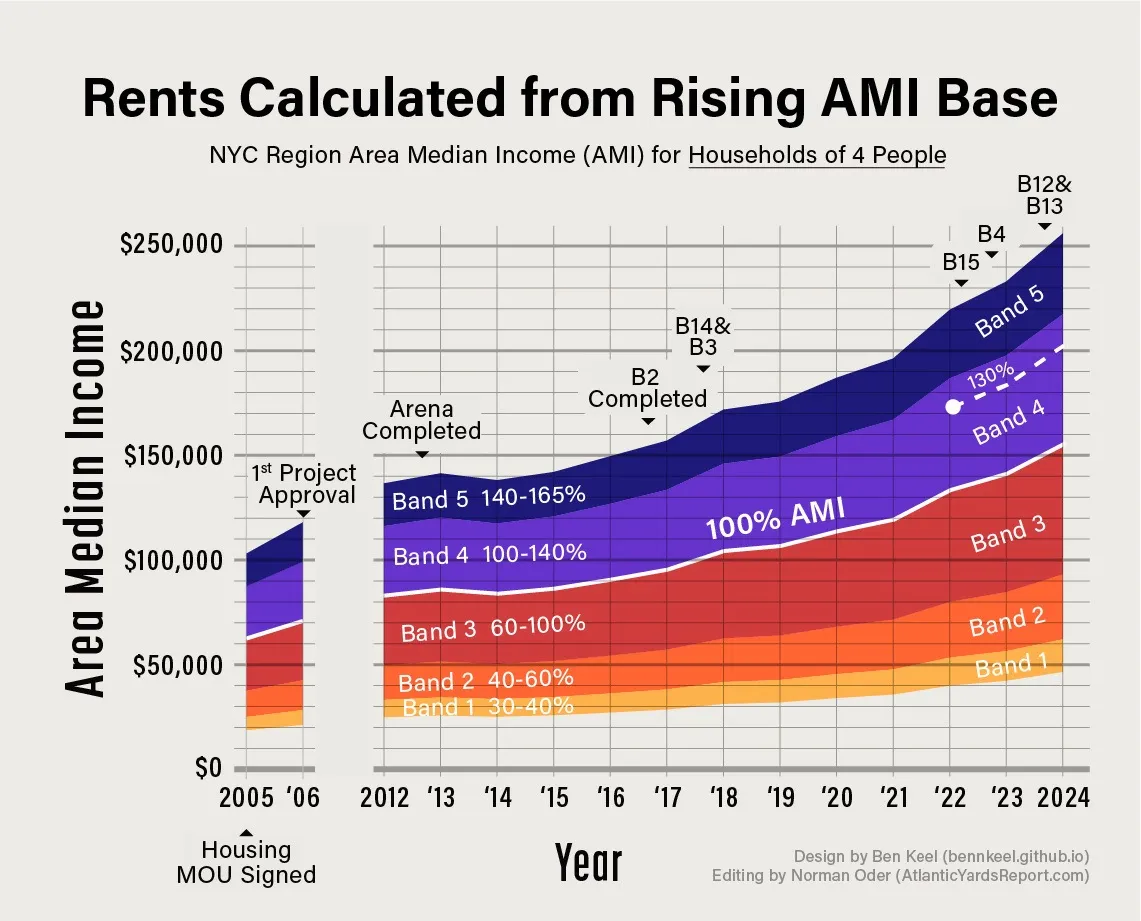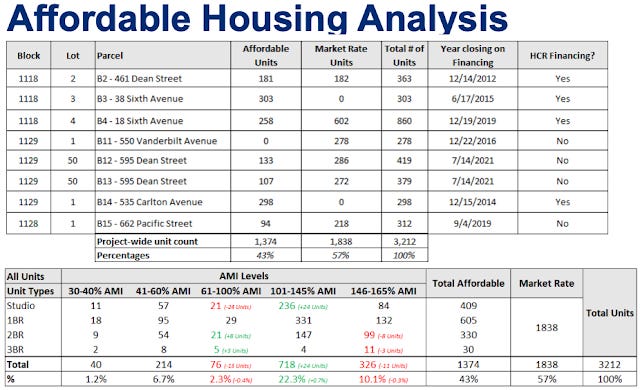"Build More Homes for Families," urges developer and former Deputy Mayor Glen. Sure, wasn't that the (unenforceable) Atlantic Yards plan?
Build More Homes for Families, real estate developer and former Deputy Mayor for Housing and Economic Development Alicia Glen wrote June 26, 2024 for Vital City:
The average two-bedroom apartment in New York now rents for $5,145 per month. That means a family needs to earn at least $200,000 in order to “afford” that apartment without being rent-burdened (rent burden is defined as spending more than 30% of income on rent). But the area median income for a family of four is only $155,300, a whopping 25% less than what they need.Indeed, see the rising Area Median Income in Ben Keel's graphic below. The line for 100% AMI, as of 2024, now rises slightly about $150,000.
Others, she notes, can't afford to move out, but can't afford to stay. But we're not building for them, either:
A review of affordable apartments — by which I mean housing that is income-tested and rent-restricted — completed in New York City in the last five years shows that almost 28,000 studios and one-bedrooms were built as compared to just over 11,000 two-bedroom units and only 2,500 three-bedrooms.
The trend in other cities is similar. Her suggested agenda pushes back on the last few mayor administration's foci on unit counts:
- Impose requirements that developers build a set threshold of family-sized units in projects developed on public land;
- Tie the receipt of direct subsidy or tax incentives to the creation or preservation of larger apartments;
- Enact a series of actions designed to help “right-size” housing. Free up bedrooms and larger apartments by building more affordable senior housing and incentivizing construction of Accessory Dwelling Units and “in-law” flats.
- Implement zoning changes to promote larger, family-sized units; Mayor Adams’ “City of Yes for Housing Opportunity” plan gets a lot right, but this is an oversight.
- Amend building and other relevant codes to promote innovative design and construction approaches to make dwelling units more flexible, allowing owners to accommodate changing family composition.
Earlier this year, Empire State Development (ESD), the state authority that oversees/shepherds Atlantic Yards/Pacific Park, delivered an Affordable Housing Analysis to the advisory Atlantic Yards Community Development Corporation (AY CDC).
As the chart indicates, of the 1374 total below-market units built so far, 360, or 26.2%, were two bedrooms or larger.
They were, in floor area, through original developer Forest City Ratner couldn't resist fudging it to imply that pledge covered half the 2,250 promised income-targeted units.
The pledge, though promoted by ESD and part of an Affordable Housing Memorandum memorialized in a private, unenforceable Community Benefits Agreement, was not memorialized in the guiding Development Agreement. Instead, the configuration was influenced by the developer’s bottom line and the contours of government subsidy programs and tax breaks.
Notably, among the last four towers built, there are zero three-bedroom affordable units.
By my estimate, more than 35% of the units would have to be two-bedrooms or larger to meet the floor-area pledge.
Putting it all together
So, how does this fit with Glen's prescriptions, notably "Impose requirements that developers build a set threshold of family-sized units in projects developed on public land."
Well, the administration of Mayor Bill de Blasio, in which Glen served, did manage to get 35% family-sized units in the "100% affordable" towers 535 Carlton Ave. and 38 Sixth Ave., though those buildings were skewed to middle-income households. (de Blasio succeeded Mike Bloomberg, during whose administration Atlantic Yards was approved.)
Those buildings benefit from some special subsidies, whereas later buildings, launching in the last days of the de Blasio administration or beyond, simply relied on the 421-a tax break.
But if we substitute the phrase "projects developed with significant governmental assistance" for "projects developed on public land," well, the pledge for family-sized units could have been--and should have been--locked into the project's guiding documents. It wasn't.


Comments
Post a Comment